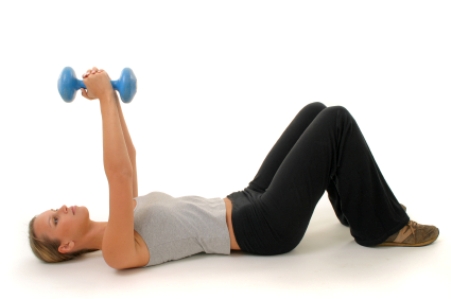Exercise Program Repetitions (REPS)
The best way to know how long to do a certain exercise is by how it feels. If the muscles being worked do not tire somewhat, they are not being challenged. We suggest that the decision to stop be made at one of three points: (1) when the muscles begin to tire; (2) when the muscles are moderately fatigued and it takes some willpower to continue; or (3) when another repetition workout cannot be properly performed. As your condition improves, you will find yourself using the third option more often. Although the point of diminishing returns is reached after about forty repetitions of many exercises, some people benefit by going beyond that number.
A exercise program repetition workout is defined as a complete performance of a given exercise. Completing a motion with the left leg, then the right, is one rep, not two. In some exercises, it works best to do all the right reps first, then all the left. Twenty reps, then, means twenty with the right leg and twenty with the left.
For those who are unable to decide how many repetitions to do for a given exercise, we offer more specific guidelines according to whether you are at the beginner, intermediate, or advanced level.
If this is your first exercise program or if you are in poor shape, you are a beginner and should do the number of repetitions workout recommended for that category. If you are in good shape, play tennis or other sports regularly, or swim, you could probably start at the intermediate stage. If you run regularly, play racquet ball, workout hard, or feel for other reasons that you are in top shape, you might want to try the lower part of the advanced stage-but it would probably be best to work up to it. Each exercise description indicates how many reps to perform, according to your category or condition.
Exercise Groups
We have grouped these exercises according to the areas of the body most affected by them. After doing the warm-up exercises, choose any one of the regular exercise groups-or all of them. When doing these exercises, you will find while you’re working on, say, your hips, the buttocks and thighs will benefit, too. Even the stomach muscles and waist are worked out in many of the exercises.
Remember, however, that this program is not meant to be a complete regimen for the entire body, but is intended for those who wish to concentrate their efforts on the target areas we have discussed.
In addition to the six main target-area exercise groups, you can also benefit by adding some from the group of vigorous ex exercises (see page 86). Exercising specific parts of the body does not necessarily lead to weight loss but will burn off calories, causing a decrease in the amount of fat throughout the body. You will notice a reduction in inches and feel the firming and toning effects.
Staying slim and trim, losing bulges and bumps and flab, is hard work but can be fun as well as rewarding. This book was written for those who, like us, are willing to take the time and make the effort to maintain good health, a trim figure, and a vigorously positive attitude.

